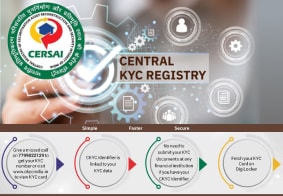CKYC Registry
-
Customer Service Contact us Service request Locate a branch
Find all the help you need
Scan the QR, get our app, and find help on your fingertips

Help CenterSupport topics, Contact us, FAQs and more
-
Login
Are you ready for an upgrade?
Login to the new experience with best features and services
-
Login
Are you ready for an upgrade?
Login to the new experience with best features and services
- Accounts
-
Deposits
IDFC FIRST Bank Deposits
View all Deposits -
Loans
IDFC FIRST Bank Loans
View all Loans - Wealth & Insure
-
Payments
IDFC FIRST Bank Payments
View all Payments -
Cards
IDFC FIRST Bank Cards
View all Cards - Blogs
- Corporate Account
-
Cash Management Services
IDFC FIRST Bank Cash Management Services
View all Cash Management Services - Supply Chain Finance
-
Corporate Lending
IDFC FIRST Bank Lending
View all -
Treasury
IDFC FIRST Bank Treasury
See more details - NBFC Financing
Support topics, Contact us, FAQs and more
- IDFC FIRST Bank Accounts
-
Savings Account
-
Corporate Salary
Account -
Senior Citizens
Savings Account -
First Power
Account -
Current Account
-
NRI Savings
Account -
TASC Institutional
Account -
Savings Account
Interest Calculator
- IDFC FIRST Bank Deposits
-
Fixed Deposit
-
Recurring Deposit
-
NRI Fixed Deposit
-
Safe Deposit Locker
-
FD Calculator
-
RD Calculator
- IDFC FIRST Bank Loans
-
Personal Loan
-
Consumer Durable
Loan -
Home Loan
-
Business Loan
-
Professional Loan
-
Education Loan
-
New Car Loan
-
Pre-owned Car Loan
-
Two Wheeler Loan
-
Pre-owned Two
Wheeler Loan -
Commercial Vehicle
Loan -
Gold Loan
-
Loan Against Property
-
Loan Against Securities
-
Easy Buy EMI card
-
Personal Loan
EMI Calculator -
Education Loan
EMI Calculator -
Home Loan
EMI Calculator
- IDFC FIRST Bank Wealth & Insure
-
FIRST Select
-
FIRST Wealth
-
FIRST Private
-
Mutual Funds
-
Sovereign Gold Bond
-
Demat Account
-
Term Insurance
-
Life Insurance
-
Health Insurance
-
General Insurance
-
Bonds
-
Loan Against
Securities -
Portfolio Management
Service
- IDFC FIRST Bank Payments
-
FASTag
-
Credit Card
Bill Payments -
UPI
-
Funds Transfer
-
Forex Services
-
Pay Loan EMI
- IDFC FIRST Bank Cards
-
Ashva :
Metal Credit Card -
Mayura :
Metal Credit Card -
FIRST Millennia
Credit Card -
FIRST Classic
Credit Card -
FIRST Select
Credit Card -
FIRST Wealth
Credit Card -
FIRST WOW!
Credit Card -
Deals
-
Debit Cards
-
Co-branded Cards
-
Credit Card
EMI Calculator -
FIRST Corporate
Credit Card -
FIRST Purchase
Credit Card -
FIRST Business
Credit Card
- Premium Metal Credit Cards
-
AshvaLifestyle1% Forex₹2,999
-
MayuraLifestyleZero Forex₹5,999
-
FIRST PrivateInvite Only
- Best for travellers
-
MayuraZero ForexMetal₹5,999
-
Ashva1% ForexMetal₹2,999
-
FIRST WOW!Zero ForexTravelLifetime Free
-
FIRST SWYPTravel OffersEMI₹499
-
FIRST Select1.99% ForexLifestyleLifetime Free
-
FIRST Wealth1.5% ForexLifestyleLifetime Free
-
Club VistaraTravelLifestyle₹4,999
-
IndiGo IDFC FIRST Dual Credit CardTravelLifestyle₹4,999
- Max benefits, Free for life
-
FIRST Classic10X RewardsShoppingNever Expiring Rewards
-
FIRST Millennia10X RewardsShoppingNever Expiring Rewards
-
FIRST Select10X RewardsLifestyle1.99% Forex
-
FIRST Wealth10X RewardsLifestyle1.5% Forex
-
FIRST WOW!RewardsTravelZero Forex
-
LIC ClassicRewardsInsuranceShopping
-
LIC SelectRewardsInsuranceShopping
- Reward Multipliers
-
AshvaLifestyleMetal₹2,999
-
MayuraLifestyleZero Forex₹5,999
-
FIRST ClassicNever Expiring RewardsShoppingLifetime Free
-
FIRST MillenniaNever Expiring RewardsShoppingLifetime Free
-
FIRST SelectNever Expiring RewardsLifestyleLifetime Free
-
FIRST WealthNever Expiring RewardsLifestyleLifetime Free
- Rewards & Credit on UPI
-
FIRST Power+FuelUPI₹499
-
FIRST PowerFuelUPI₹199
-
FIRST EA₹NVirtual1% Cashback₹499
-
FIRST DigitalVirtualUPI₹199
-
IndiGo IDFC FIRST Dual Credit CardUPITravelDual cards
- Fuel and Savings
-
FIRST PowerRewardsUPI₹199
-
FIRST Power+RewardsUPI₹499
-
LIC ClassicRewardsInsuranceShopping
-
LIC SelectRewardsInsuranceShopping
- Express and Flaunt
-
AshvaMetal1% Forex₹2,999
-
MayuraMetalZero Forex₹5,999
-
FIRST SWYPEMIOfferMAX₹499
-
FIRST MillenniaRewardsShoppingLifetime Free
- FD Backed rewarding Credit Cards for all
-
FIRST EA₹NVirtualCashback₹499
-
FIRST WOW!Zero ForexTravelLifetime Free
-
CreditPro Balance TransferTransfer & SaveReduce InterestPay Smartly
- IDFC FIRST Bank NRI Forex Solutions
-
Send money to India-Wire transfer
-
Send money to India-Digitally
-
Send money abroad
-
Max Returns FD (INR)
- IDFC FIRST Bank MSME Accounts
-
Platinum Current
Account -
Gold
Current Account -
Silver Plus
Current Account -
Merchant Multiplier
Account -
Agri Multiplier
Account -
TASC Institutional
Account -
Dynamic Current
Account -
World business
Account -
First Startup
Current Account
- IDFC FIRST Bank Business Loans
-
Business Loan
-
Professional Loan
-
Loan Against Property
-
Business Loan for Women
-
Working Capital Loan
-
Construction Equipment Loan
-
Machinery Loan
-
Healthcare Equipment Loan
- IDFC FIRST Bank Business Solutions
-
Payment Solutions
-
Tax Payments
-
Doorstep Banking
-
Point of Sale (POS)
-
Escrow Accounts
-
NACH
-
Payment Gateway
-
UPI
-
Virtual Accounts
-
As per amendment in the Income Tax Rules, PAN or Aadhaar are to be mandatorily quoted for cash deposit or withdrawal aggregating to Rupees twenty lakhs or more in a FY. Please update your PAN or Aadhaar. Kindly reach out to the Bank’s contact center on 1800 10 888 or visit the nearest IDFC FIRST Bank branch for further queries.
-
-
Most Searched
Sorry!
We couldn’t find ‘’ in our website
Here is what you can do :
- Try checking the spelling and search
- Search from below suggestions instead
- Widen your search & try a more generic keyword
Suggested
Get a Credit Card
Enjoy Zero Charges on All Commonly Used Savings Account Services
Open Account Now
Personal Loan
What is a Key Fact Statement of a Loan and Why Is It Crucial?
Key Takeaways
A key fact statement (KFS) is a document provided by the banks that summarises the critical aspects of a loan including the loan amount, interest rate, repayment schedule, fees, and the total repayment amount.
Key fact statements are crucial for regulatory compliance, transparency, and effective financial planning.
Key fact statements can be accessed online on the bank’s website, physical branches, or via email upon request.
A KFS serves as a roadmap to understanding loan terms, enabling borrowers to manage their loans responsibly and make sound financial decisions.
Understanding the facets of personal loans can be daunting, with numerous terms and conditions that can easily overwhelm the average borrower. This is where the Key Fact Statement (KFS) comes into play. A KFS is a document that provides a clear and concise summary of the most important details of a loan, such as the loan amount, interest rate, repayment schedule, fees, and the total repayment amount. By simplifying the key elements of a loan, the KFS helps borrowers make well-informed decisions before committing to a financial product.
Considering updates by the Reserve Bank of India (RBI), the KFS has become even more critical for ensuring transparency and regulatory compliance in India’s lending ecosystem. On April 15, 2024, the RBI introduced new guidelines that supersede the previous KFS regulations. These new rules are now the standard for all lenders in India, including banks, NBFCs, and fintech companies.
At IDFC FIRST Bank, we are committed to ensuring that our borrowers have complete clarity about the loans they take. In this article, we’ll break down the KFS, its components, and why it’s essential for both borrowers and lenders to comply with these new guidelines.
READ MORE
What is a key fact statement?
A key fact statement is designed to promote transparency and help borrowers make informed decisions. KFS is a document provided by the bank that summarises the main features and terms of a loan. It serves as a concise guide to the essential facts about a loan, ensuring that borrowers have a clear understanding of the financial product they are considering.
A key fact statement is your roadmap to understanding loan terms—empowering you to make informed decisions with clarity and confidence in your financial journey. The KFS typically contains the following information:
- Loan amount: The total amount of money being borrowed.
- Interest rate: The percentage charged on the loan amount, which can be fixed or variable.
- Repayment schedule: Details on the frequency and amount of each payment, including the loan tenure.
- Fees and charges: A breakdown of all applicable fees, such as processing fees, late payment charges, and prepayment penalties.
- Total repayment amount: The total amount to be repaid over the life of the loan, including interest and fees.
- Terms and conditions: Specific conditions associated with the loan, such as collateral requirements or special clauses.
- Contact information: Details of the lender's contact information for any queries or concerns.
Why is a Key Fact Statement Important?
The importance of a key fact statement cannot be overstated. It plays a pivotal role in the borrowing process for several reasons:
- Clarity and transparency: The KFS provides a clear and concise summary of the loan terms, helping borrowers understand what they are agreeing to.
- Informed decision-making: By presenting all relevant information upfront, the KFS empowers borrowers to compare different loan products and choose the one that best suits their needs.
- Regulatory compliance: The provision of a KFS ensures that lenders comply with regulatory requirements aimed at protecting consumers.
- Financial planning: With detailed information on repayment schedules and total costs, borrowers can plan their finances more effectively.
Key Updates to the KFS Guidelines by RBI (Effective April 15, 2024)
In April 2024, the Reserve Bank of India (RBI) introduced significant updates to the KFS guidelines, which all lenders must follow. These changes aim to strengthen the transparency and fairness of the lending process, ensuring that borrowers have access to all the necessary information to make informed decisions. Here are the key updates:
- Mandatory for MSME and Retail Loans: KFS is now mandatory for all MSME (Micro, Small, and Medium Enterprises) and retail term loan products. Credit card products are exempt from this requirement. If you are a borrower looking for an MSME or retail loan, you will now receive a KFS document outlining all the key loan details.
- Standardized Format: The RBI has provided a standardized format for the KFS and its attachments, which lenders must follow. This format is outlined in Annexures A, B, and C of the RBI guidelines. Lenders, including IDFC FIRST Bank, must update their KFS documents to comply with this new format.
- Local Language Requirement: To improve accessibility and ensure that all borrowers can understand the loan terms, the RBI now mandates that the KFS be provided in a language understood by the borrower. This will help ensure that borrowers from diverse linguistic backgrounds can fully comprehend the details of their loans.
- Borrower Acknowledgment: Lenders are now required to obtain an acknowledgment from borrowers confirming that they have understood the KFS. This acknowledgment must be obtained before the loan agreement is sent to the borrower, ensuring that the borrower is fully informed before making any commitments.
- KFS to be Included in Loan Agreement: The KFS must now be included in the loan agreement as a summary box. This makes it easier for borrowers to see the key loan details within the context of the full agreement.
- Explicit Borrower Consent for Amendments: If there are any changes to the loan terms after the KFS is provided, lenders must obtain explicit consent from the borrower. This ensures that borrowers are fully aware of any modifications to the original terms.
- Evaluation Period for Borrowers: Borrowers are now entitled to a minimum evaluation period before they sign the KFS. For loans with a tenure of more than seven days, borrowers must be given at least three days to review the loan terms. For loans with a tenure of less than seven days, the evaluation period is reduced to one day.
Understanding loan terms through a key fact statement
The KFS breaks down complex financial jargon into easily understandable terms. For instance, instead of just stating the interest rate, the KFS explains whether it is fixed or variable and how it impacts the monthly payments. Similarly, the breakdown of fees and charges helps borrowers identify any hidden costs, ensuring there are no unpleasant surprises later.
Moreover, the repayment schedule included in the KFS allows borrowers to see the exact timeline of their financial commitment. This transparency helps in assessing the affordability of the loan and planning future finances accordingly.
Validity of a Key Fact Statement
It’s important to note that the validity of a KFS depends on the length of the loan. For loans longer than seven days, the KFS is valid for three days, providing a reasonable window for borrowers to review the details. For loans shorter than seven days, the KFS is valid for just one day, ensuring that borrowers make quick decisions based on the most up-to-date information.
Reliable lenders like IDFC FIRST Bank offer clear and transparent loan terms along with low personal loan interest rates for affordable borrowing. Unique offerings from IDFC FIRST Bank such as FIRSTmoney smart personal loan not only gives you flexibility to avail multiple loans, but also lets you pay EMIs only on the consumed amounts. You can apply for smart personal loans from FIRSTmoney completely online and get instant approvals of amounts of up to ₹10 lakhs for meeting your varying monetary needs.
How to access key fact statements?
Banks are required by law to provide the KFS to borrowers before the loan agreement is signed. Typically, the KFS is made available online on the bank website, in physical branches, or can be sent via email upon request. Borrowers should always request and review the KFS before finalising any loan to ensure they have a complete understanding of the terms and conditions.
Navigating Loans with Confidence: The Role of KFS
The key fact statement is an crucial tool in the borrowing process, providing a clear and concise summary of a loan's key aspects. The KFS ensures transparency and aids in informed decision-making. Understanding the KFS meaning, its components, can significantly enhance your financial literacy and empower you to navigate the loan landscape with confidence. Always remember to review the KFS thoroughly before committing to a loan, as it is your roadmap to understanding and managing your financial obligations effectively.
Disclaimer
The contents of this article/infographic/picture/video are meant solely for information purposes. The contents are generic in nature and for informational purposes only. It is not a substitute for specific advice in your own circumstances. The information is subject to updation, completion, revision, verification and amendment and the same may change materially. The information is not intended for distribution or use by any person in any jurisdiction where such distribution or use would be contrary to law or regulation or would subject IDFC FIRST Bank or its affiliates to any licensing or registration requirements. IDFC FIRST Bank shall not be responsible for any direct/indirect loss or liability incurred by the reader for taking any financial decisions based on the contents and information mentioned. Please consult your financial advisor before making any financial decision.
The features, benefits and offers mentioned in the article are applicable as on the day of publication of this blog and is subject to change without notice. The contents herein are also subject to other product specific terms and conditions and any third party terms and conditions, as applicable. Please refer our website www.idfcfirstbank.com for latest updates.























